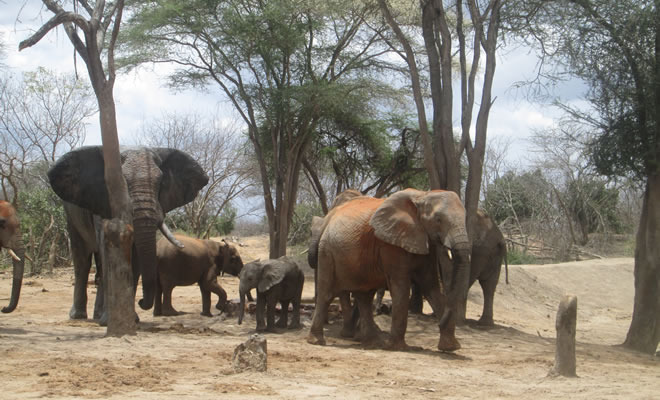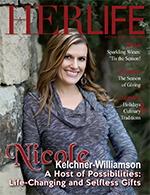 photos courtesy of David Sheldrick Wildlife Trust and Brenda Atkinson
photos courtesy of David Sheldrick Wildlife Trust and Brenda Atkinson
David Sheldrick Wildlife Trust
“Once I walked ahead of the matriarch and I felt this gentle touch of her trunk against my back as if to say, ‘Hey, lady, I’m in charge of this herd,’” recalled Brenda. “But they are sensitive and fragile. They can feel fear. They do have an incredible memory and can harbor a grudge against someone who hurts them. But they also remember if someone helps them, like a veterinarian who pulls out an arrow. Elephants will kiss you, make happy sounds and be glad to see you.”
In Africa, one elephant is killed every 15 minutes for its ivory tusks. This is an astounding rate, with fewer than 350,000 elephants alive today, and if humanity doesn’t intervene and stop this slaughter, the elephant could be extinct in the wild in as few as ten years! With such devastating statistics and horrifying circumstances, it’s no wonder that Boise resident and world-wide traveler Brenda Atkinson has embraced the mission of the Kenya-based David Sheldrick Wildlife Trust (DSWT), an organization committed to the conservation, preservation and protection of wildlife.
Founded more than 37 years ago by Dr. Dame Daphne Sheldrick in memory of her conservationist husband, David, the DSWT’s goals are “to stop the poaching, to spare the elephants and to put an end to the demand for ivory,” according to Brenda, who together with her husband, Robert, met Dame Daphne 15 years ago while on safari in Africa for their travel publication, The Hideaway Report.
The DSWT is best known for its pioneering work in the rescue and hand-rearing of orphaned baby elephants, which has seen more than 160 baby elephants saved, with over 90 of them now living back in the wild. The Orphan’s Project is just one element of the DSWT’s multi-faceted approach to wildlife conservation, which incorporates fully trained anti-poaching teams, mobile veterinary units, aerial surveillance, community engagement, habitat protection and campaigning. Together these programs enable the organization to offer hope to elephants, rhinos and all wild species in Kenya, but it is the elephants that so desperately need their protection today.
Quanza is an elephant that was rescued by the group two years ago, in October 2012, as elephant poaching in Africa began to reach a peak. Only one year old, Quanza was found standing close to the bodies of her mother and two sisters, all three of them killed for their ivory. By the time the ground teams reached the scene, poachers had used axes to cut out the ivory of the three adult elephants, which in its raw form is worth a staggering $3,000 per kilo in China. Quanza was left alive; she was too young to have tusks and thus not worth wasting a bullet.
Poaching of elephants has been escalating since 2008, when, despite an international ban on the sale of ivory, the Convention on the International Trade in Endangered Species of Flora and Fauna (CITES) approved the “one-off” sale of ivory to China. The flawed logic, which conservationists warned of at the time, was that by flooding the Chinese market with ivory it would stem the illegal ivory trade and thus reduce elephant poaching. In reality, it re-ignited the trade; the value of ivory skyrocketed and poaching followed suit, with more than 100,000 elephants killed in the last three years alone.
Using AK-47s or Russian-made Kalashnikov rifles, the poachers are often better armed than wildlife rangers, and they have become proficient in the task of killing an elephant and swiftly removing its tusks before rangers are able to respond. Other times, elephants are shot with poisoned arrows and poison-tipped spears; depending on the potency of the poison, an elephant can suffer for a day, a week or even a month before it succumbs from blood poisoning.
“Elephants are savagely murdered for their ivory tusks,” explained Brenda. “It is disgustingly brutal and very traumatic. Poachers butcher the elephant mothers and bulls right in front of their babies. Many times the baby will put its trunk on its dying mother; some even try to get milk from its mother. They cry out for help, a haunting sound, and they grieve much like humans do. Elephants mourn their dead like we do. They have compassion; elephants are highly intelligent and can and think.”
As the world looks the other way, the illegal ivory trade is thriving and surviving, and, little known to most, supplying funding for terrorist organizations such as the Somalian wing of Al Qaeda, the Lord’s Resistance Army and Darfur’s Janjaweed. “The prized ivory tusks are sold and the money is then used to purchase weapons for these terrorist groups, not to mention the organized crime syndicates that are linked to them that fund weapon sales, human trafficking and the drugs trade,” stated Brenda, a retired U.S. Department of Defense official who also served as a weapons systems analyst in the Office of the Army’s Chief of Staff. “There’s so much corruption and graft in Africa. The increasingly affluent middle class in China in particular covet their ivory trinkets because it’s considered a status symbol in their culture. It’s deeply ingrained in the Asian culture to want ivory, as it represents purity, once you wash the blood off of it. One of China’s former empresses insisted that her chopsticks be made of pure ivory because if her food was poisoned, real ivory would change colors. It’s a ridiculous fallacy that illustrates just how intensely valued this creamy-white material that makes up the tusks is in some societies.
“A uniquely Chinese concern is loss of face, public shame and disgust of their acts and policies. The barbaric backing of the slaughter of Africa’s elephants should receive worldwide attention and condemnation. It might help influence governments and change things,” Brenda remarked. “The African people and the elephants share common tormentors, another reason why they need worldwide help. We must make a concerted effort to get rid of the ivory dealers as well as poachers. Global cooperation is needed on all levels–private corporations, public companies, retired military employees, government agencies, students, celebrities and philanthropists–all of us. There’s got to be action; it’s not enough to talk anymore. It is possible to do, but first we need to close the domestic ivory market in China, as well as in the U.S., which is the second largest ivory-consuming nation. We must institute a ‘crush and ban ivory’ policy to discourage poachers, dealers and customers.” Brenda’s conviction and passion about this issue and the work of the David Sheldrick Wildlife Trust is evident in her voice as she mentions her educational outreach speech at Boise State’s Honors College this month.
Sadly, well-known groups such as the World Wildlife Fund and the Wildlife Conservation Society are too large to be effective working strategically together. The UN Convention on International Trade in Endangered Species of Wild Flora and Fauna convenes but rarely takes action, according to Brenda’s observations throughout the years. Due to its small size and dedicated staff, the David Sheldrick Wildlife Trust cuts through the red-tape found in bureaucracy and avoids corruption. When you make a donation to the DSWT, your money goes directly to the care and rehabilitation of orphaned elephants, anti-poaching operations, mobile veterinary intervention, aerial surveillance and community outreach programs to teach Africa’s youth about these magnificent creatures.
Once they are rescued, orphaned baby elephants like Quanza, who lost her entire family to ivory poaching, are taken to the DSWT’s Elephant Nursery in Nairobi National Park. From there they are given a second chance at life, in the company of other orphaned elephants–the DSWT currently has 32 baby elephants, under two years of age at the Nursery–and their human caregivers, who act as surrogate mothers to the orphans. Because elephants are highly social animals, they are reliant on their mothers for the first few years of life, and the DSWT works to replace their lost family with human keepers who feed the babies their special milk formula every three hours, day and night, and even sleep in the stable with the orphans. Much like human babies, young elephants need their parents to help them develop and to keep them safe.
As is true with human babies, elephant babies can’t tolerate cow’s milk. It took years for Dame Daphne and her associates to develop a nutritionally sound formula for baby orphaned elephants. British Airways generously donates flight time and expenses to fly in this special milk. As with humans, a baby elephant’s skin is sensitive to the sun’s harmful rays, so they use their mother’s ears for shade. Elephants teethe just like their human counterparts and their lifespan and stages mimic those of humans.
Beyond the Nursery, there are rehabilitation units located in Ithumba and Voi in the vast Tsavo East National Park and a new rehabilitation unit in the Kibwezi Forest. The infants from the Nursery will graduate to these locations between the ages of two and three years. Here they have the opportunity to mix with wild elephants and to learn the skills they need to ultimately return to a wild life. Earlier this year, Quanza, along with four other elephant orphans, moved from the Nursery to the Kibwezi Forest Unit, where they have begun mixing with wild herds. It is here that they will ultimately return to a life back in the wild.
“The dedicated staff at the DSWT emphasize rearing orphaned elephants in such a way that they grow up psychologically sound and able to take their place back where they belong to enjoy a normal life amongst the wild elephant community,” said Brenda. Orphaned elephants live with their keepers for several years before being reintroduced into the wild. The Tsavo Conservation area in Kenya provides more than 64,000 square kilometers of natural habitat, the space an elephant needs to have quality of life. Despite the attractive look of man-made environments in captivity, in reality it’s never adequate living space for these beautiful creatures.
Brenda is currently fostering three orphaned elephants, Kithaka, Barsilinga, and Orwa. Having spent some time in the African bush, she adores these gentle giants who exhibit many human feelings such as love, care and community. The matriarch is the head of the herd, in charge of both discipline and affection. “Once I walked ahead of the matriarch and I felt this gentle touch of her trunk against my back as if to say, ‘Hey, lady, I’m in charge of this herd,’” recalled Brenda. “But they are sensitive and fragile. They can feel fear. They do have an incredible memory and can harbor a grudge against someone who hurts them. But they also remember if someone helps them, like a veterinarian who pulls out an arrow. Elephants will kiss you, make happy sounds and be glad to see you.”
DSWT is now run by Angela Sheldrick, daughter of Daphne and David, who together with her husband, Robert, and their two sons, live and work in Africa and are eager to ensure that David and Daphne’s legacy continues. Working tirelessly with Daphne on behalf of these gentle creatures is UK Director Robert Brandford, who heads the London Office of the DSWT, and Melissa Sciacca, the Executive Director of the U.S. Friends of The David Sheldrick Wildlife Trust. The Trust’s four head keepers include Benjamin, for the Ithumba unit; Edwin, at the Nairobi Orphanage; and Joseph, who heads the TsavoVoi unit. Field operations officer and chief pilot Nick Trent flies the little yellow Cessna prop plane, supported by two other pilots operating the Super Cubs. This year, with direct support from actress Kristin Davis, patron of the DSWT, the Trust secured a helicopter, which has vastly increased the rate at which they can respond to wildlife cases and, where needed, treat and save iconic elephants that have been targeted by poisoned arrow poachers. In a ten-day period in August they saved 13 elephants, each hit by a poisoned arrow, each saved through the rapid intervention of the Trust.
With the holidays fast approaching, consider adopting an orphaned elephant as a meaningful gift for family, friends and co-workers, and be a part of their healing.
For more information, visit the organization’s website at sheldrickwildlifetrust.org and keep in touch with all the charity’s wildlife operations through their social media channels, including Facebook, facebook.com/thedswt.









